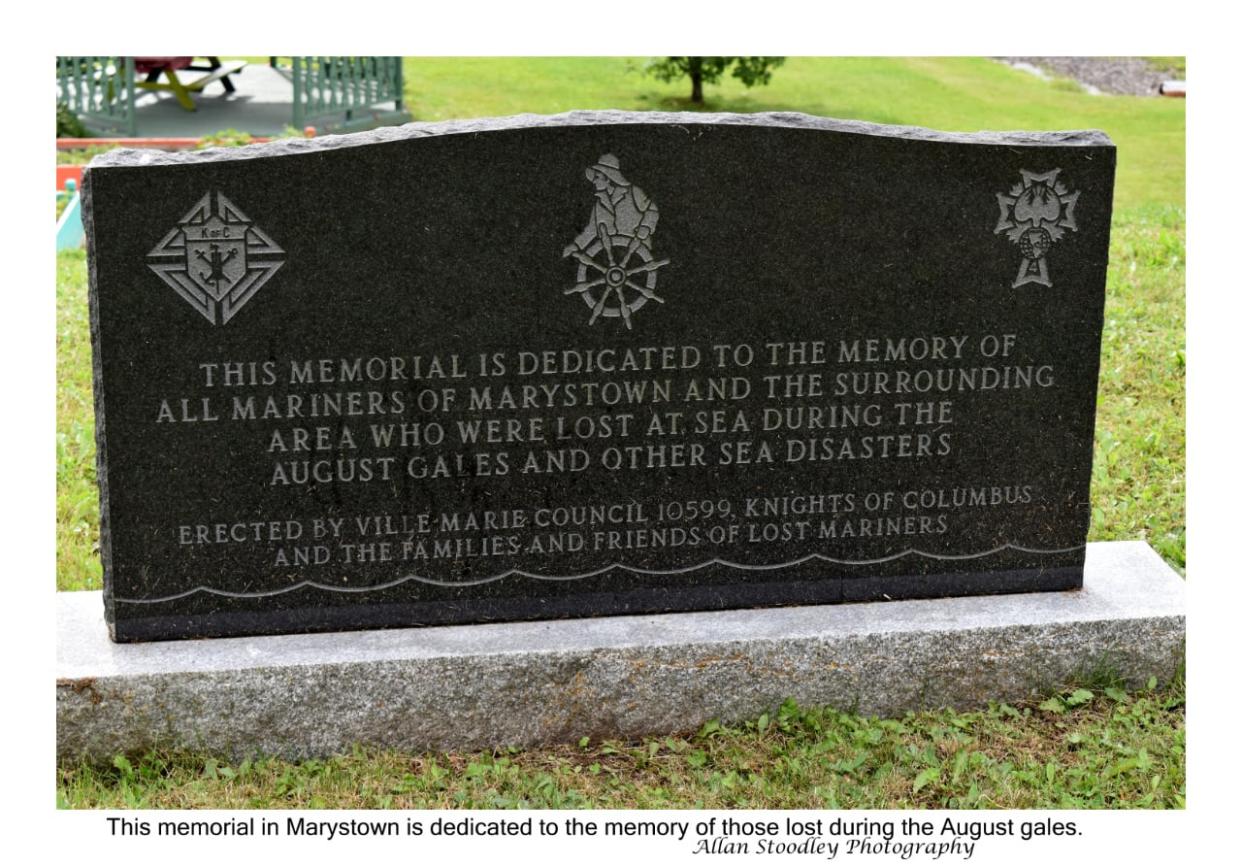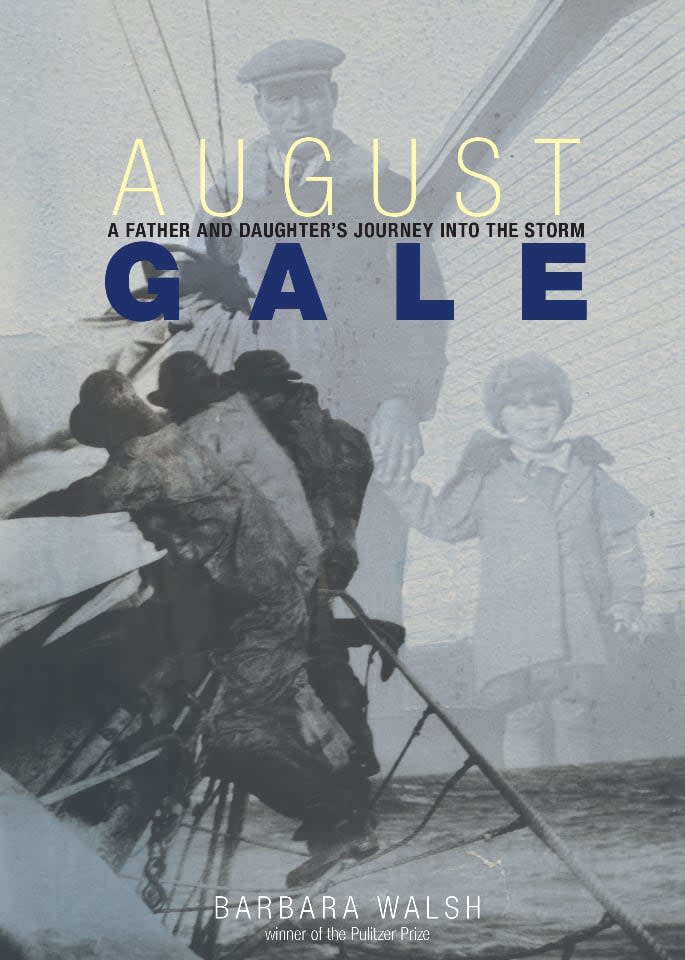August and September gales have claimed the lives of many Placentia Bay fishermen


This memorial to all mariners of Marystown and surrounding areas, who were lost at sea during the August Gale of 1935 and other sea disasters, was erected by the Ville Marie Council of the Knights of Columbus and the families and friends of lost mariners. (Allan Stoodley)
Environment Canada's warning about the possibility of more storms this hurricane season is a reminder of how far weather forecasting has come from years ago, when our fishermen from Placentia Bay in their small schooners would leave port to fish off Cape St. Mary's — and tragically, many, many lives would be lost.
A fierce storm — reported to have been the worst in 36 years — roared up the eastern seaboard and made landfall in southeastern Newfoundland during the afternoon of Aug. 25, 1935.
Loss estimates vary. According to an Environment Canada listing of some of the worst weather events in Canadian history, said the August storm killed at least 34 people, with another 15 unconfirmed but missing). The St. John's Daily News — one of the newspapers of the day — reported 31 people were killed in the gale that resulted in thousands of dollars of property damage.
A daughter's personal tale
In 2012 American Pulitzer Prize-winning journalist and magazine columnist Barbara Walsh published an excellent book entitled August Gale: A Father and Daughter's Journey into The Storm.
The book not only deals with the hurricane that took so many lives of Placentia Bay fishermen, but it also superbly tells the personal story of her own family — with its secrets, bitterness and, finally, personal reconciliation.
"Despite many gut-wrenching stories over my 35 plus years career, August Gale was one of the most difficult stories to report and write," Walsh, 65, told me recently.
"I was asking my father about his childhood pain of being abandoned by his father. I was interviewing my ancestors from Marystown I never knew about the killer 1935 gale that claimed 12 men and two young boys in a village of 300. Every home lost a father, an uncle, brother or son —no home was untouched by the tragedy."
Walsh told me that she's working on getting August Gale made into a movie.
"I have written a screenplay, but since scriptwriting is not my forte, I'd love to collaborate with a Canadian screenwriter/producer. It would also be terrific to film the movie or series in Newfoundland, where much of the book takes place."
In September 1970 I interviewed retired schooner captain Patrick Dober, who was 81 at the time. Despite his advanced years he vividly remembered his younger years.

Barbara Walsh, a Pulitzer Prize-winning author and journalist, wrote August Gale, about the 1935 disaster. (Submitted by Allan Stoodley )
In the spring of 1898, when young Patrick Dober of Beau-Bois was just nine years old, Thomas Devereaux of Mooring Cove sailed the five miles across Mortier Bay to Beau-Bois to look for "a hardy boy or girl to take care of his cows," Dober said.
Dober fit the "hardy" requirement and he wanted to go to work, so he got the job. He went to live at Mooring Cove with the Devereaux family for seven months, for which he was paid a total of $12.
Young Dober must have earned himself a reputation as a good worker, because the next year he landed a job with the Marystown firm Reddy Brothers, where he earned $40 for the seven-month working season.
Dober told me he could even remember the September gale of 1897, when many Placentia Bay fishermen lost their lives. At the time a hurricane made landfall in the area, Sept. 24-25 of that year, he would have been only eight years old.
Dober said his brother Tom was fishing out of Beau-Bois in the 40-foot keel rudder-out-of-doors vessel he built and named Mary Joe. Tom and his crew were caught off Cape St. Mary's in that September storm, and he was washed overboard.

In August Gale, Barbara Walsh traces her family history in a tragic storm off Newfoundland's coast. (Submitted by Allan Stoodley)
Luckily, he became entangled in the vessel's rigging and was hauled back aboard -the Mary Joe's crosstrees were touching the water and the heavy seas swept everything off her deck.
According to Patrick Dober, it was in the same September storm that captain Patrick Burton and his seven-man crew of Boat Harbour lost their lives while anchored in their fishing vessel off Cape St. Mary's. There were also several other Placentia Bay fishermen who were washed overboard and drowned during the gale.
Patrick Dober went fishing for the first time — in a Cape St. Mary's boat in Placentia Bay — when he was 14. The next year he went bank-fishing out of Grand Bank. He continued bank-fishing for five years and when he was only 19 years he became skipper of the Marystown fishing schooner St. Clare.
At 30 he bought the Grand Bank schooner Garfield Harris for $4,000. He skippered the 72-ton, eight-dory banker for eight years and then sold her to buy a larger vessel, the 140-ton Mary Subina, which he used for "coasting" — carrying all types of cargo.
The Mary Subina sank in the Gulf of St. Lawrence five years later, when Dober and his six-man crew had a load of herring on board and were en route to Canso, N.S., from Harbour Breton Bay. After abandoning ship, all seven men were picked up by another vessel.

Captain Patrick Dober had five ships go down under him but never lost a man to sea. (Allan Stoodley)
Earlier in his career, Dober, along with 18 other men, had to abandon the fishing schooner Ruby, which was under the command of captain Joe Hiscock of Grand Bank.
Twice Dober had his ship go down under him, he told me, but he "never saw a man lost at sea." On five different occasions he picked up survivors from other boats that had gone to the bottom.
Dober gave up his role as captain in 1946 and decided to stay ashore. He worked at Stephenville for a year but the yearning for the sea was too great and he returned to it until he retired at the age of 73.
When I interviewed him he was living in Marystown with his wife, Annie, 79. whom he had been married to for 51 years. He died four years later, in March 1974.
Captain Patrick Dober was the father of well-known Marystown educator and local historian Albert Dober.
…………………………………………………………………………………………..
Photo of the book cover of "August Gale"
………………………………………………………………………………………………….
Photo of Captain Patrick Dober
Allan Stoodley Photography


